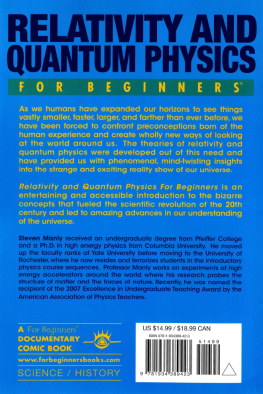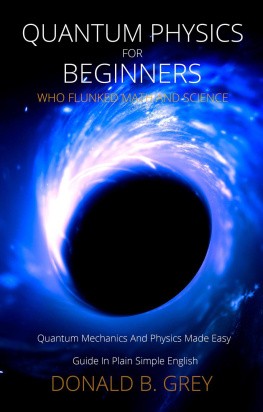WHAT IS QUANTUM PHYSICS?
How Quantum Physics Phenomena Influence Your World In an Easy and Intuitive Way
Copyright 2020 by
Jacob Orson
All rights reserved.
This document is geared towards providing exact and reliable information with regard to the topic and issue covered. The publication is sold with the idea that the publisher is not required to render accounting, officially permitted or otherwise qualified services. If advice is necessary, legal or professional, a practiced individual in the profession should be ordered.
From a Declaration of Principles which was accepted and approved equally by a Committee of the American Bar Association and a Committee of Publishers and Associations.
In no way is it legal to reproduce, duplicate, or transmit any part of this document in either electronic means or in printed format. Recording of this publication is strictly prohibited, and any storage of this document is not allowed unless with written permission from the publisher. All rights reserved.
The information provided herein is stated to be truthful and consistent, in that any liability, in terms of inattention or otherwise, by any usage or abuse of any policies, processes, or directions contained within is the solitary and utter responsibility of the recipient reader. Under no circumstances will any legal responsibility or blame be held against the publisher for any reparation, damages, or monetary loss due to the information herein, either directly or indirectly.
Respective authors own all copyrights not held by the publisher.
The information herein is offered for informational purposes solely and is universal as so. The presentation of the information is without a contract or any type of guarantee assurance.
The trademarks that are used are without any consent, and the publication of the trademark is without permission or backing by the trademark owner. All trademarks and brands within this book are for clarifying purposes only and are owned by the owners themselves, not affiliated with this document .
TABLE OF CONTENTS
CHAPTER ONE
Introduction to Quantum Physics
Quantum Mechanics, mostly called Quantum Physics, is the relationship shared among energy and matter. "Quantum" is Latin for "how much." The mechanics of this alludes to a unit that quantum physics allocates as an estimation to specific physical amounts in modest quantities. Fundamentally, quantum articulations are typically taken a gander at and concentrated on a sub-nuclear level with sub-nuclear particles.
Sub-nuclear particles are little. If a molecule were as large as a house, the sub- nuclear molecule would be as large as a gumdrop inside that house's kitchen cabinet.
There were a few things that needed to occur before the investigation of Quantum Mechanics flourished. In 1838, the disclosure of cathode beams, at that point, Gustav Kirchoff, in 1850, distributed an announcement of the "dark body radiation" issue. At that point in 1877, Ludwig Boltzmann proposed that a physical framework's energy conditions could be discrete.
In 1900, Max Planck concocted a physics that energy is transmitted and retained. At that point, he delivered a recipe that would get known as "Planck's Action Constant."
Planck is as yet known as the granddad of Quantum Physics. After his physics was distributed, different researchers observed, and abruptly, you had a couple of more physics' structures until Quantum Mechanics was being speculated and concentrated all through the world.
It is a direct result of Quantum Physics: we are nearly repulsive force, having superconductors, MRI machines in emergency clinics, and now can understand time travel is conceivable.
This all sounds so phenomenal, yet this is the thing that the researchers working in the field of Quantum Mechanics will let you know. The hardest thing for most of us to comprehend is the connection between sub-nuclear particles and the Law of Attraction.
Inside the investigation of Quantum Mechanics, it has been discovered that sub-nuclear particles take the course. Some other power is moving these structure squares of physical issues around the Universe.
After a couple of twofold visually impaired cut tests, utilizing Sub-Atomic Particles as subjects, it was found they could change from particles to wave structure at that point back once more. These particles could leave our measurement at that point pop right once more into it once more. We also discovered that these sub-nuclear particles changed from particles to wave structure, contingent upon the goal. We found that we were unable to eliminate ourselves out of the condition while testing the particles. We affected the particles by contemplating the result. There is significantly more to this.
Everything turns out to be extremely befuddling. It bewildered Einstein until the day he passed on. Getting molecule/wave duality isn't something that most of us can get our psyches around without any problem.
However, one of the speculations developed from the establishment of Quantum Physics is that we control life's very texture by contemplating it. Our contemplations have articulation that goes out. At that point brings to us what we center on. This is the Law of Attraction.
Quantum physics is the hypothetical premise of present-day material science that clarifies the nature and conduct of issues and energy on the nuclear and subatomic levels. The nature and behavior of matter and life at that level is once alluded to as quantum material science and quantum mechanics.
In 1900, physicist Max Planck introduced his quantum physics to the German Physical Society. Planck had looked to find the explanation that radiation from a gleaming body changes in shading from red, to orange, and, at long last, to blue as its temperature rises. He found that by making the presumption that energy existed in singular units similarly, that issue does, instead of a steady electromagnetic wave - as had been earlier accepted - and was like this quantifiable. He could discover the solution to his inquiry. The presence of these units turned into the primary presumption of quantum physics.
Planck composed a numerical condition including a figure to speak to these individual units of energy, which he called quanta. The state clarified the wonder well indeed; Planck found that at certain discrete temperature levels (authentic products of an essential least worth), energy from a gleaming body will possess various shading range regions. Planck accepted a physics yet to rise out of the disclosure of quanta; however, truth be told, their very presence inferred a new and principal comprehension of the laws of nature. Planck won the Nobel Prize in Physics for his physics in 1918. However, different researchers' improvements over a thirty-year time frame all added to the quantum physics's advanced comprehension.
The Development of Quantum Theory
In 1900, Planck made the supposition that energy was made of individual units or quanta.
In 1905, Albert Einstein speculated that the power, yet the radiation itself was quantized similarly.
In 1924, Louis de Broglie suggested that there is no crucial distinction in the cosmetics and conduct of energy and matter; on the nuclear and subatomic level, either may act as though made of either particles or waves. These physics got known as the rule of wave-molecule duality: elementary particles of both energy and matter carry on, contingent upon the conditions, as either particles or waves.
In 1927, Werner Heisenberg suggested that exact, synchronous estimation of two reciprocal qualities -, for example, the position and force of a subatomic molecule - is unimaginable. As opposed to traditional material science standards, their simultaneous estimation is inevitably imperfect; the more precisely one worth is estimated, the more defective will be to assess the other value. These physics got known as the vulnerability guideline, which incited Albert Einstein's famous remark, "God doesn't play dice."



